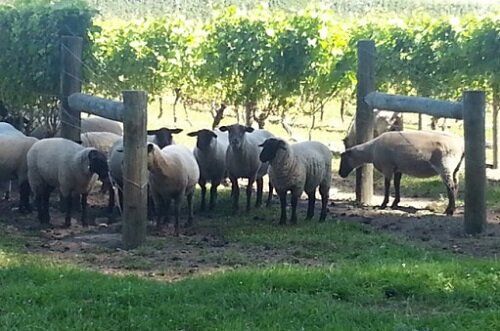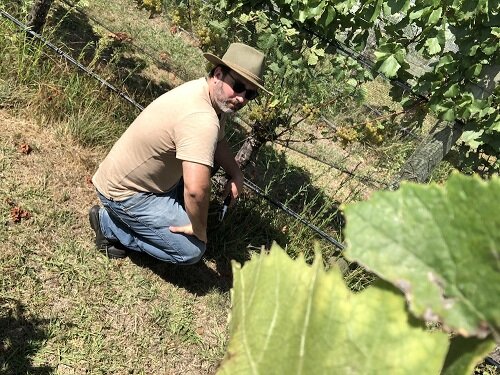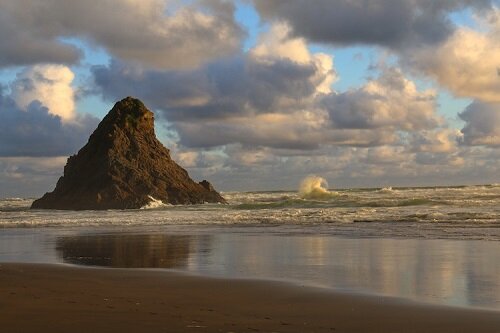New Zealand Wine’s Symbiotic Relationship with the Natural World
In New Zealand taking a step forward means looking back to native Māori values and culture and being inspired by nature. Hailed as one of the most ecologically unique and diverse places on the planet; the country has the most varied seabird community on earth, 40 species of reptiles that can’t be found anywhere else, and about 1,900 of its 3,400 vascular plants are endemic.
History of New Zealand
Sheep photo credit Waipapa Bay Wines
For millions of years, New Zealand belonged to the animals, the plants and the birds, as the edges of the sea and its array of inhabitants lapped at the 103,483 square mile emerald archipelago, 1,200 miles southeast of Australia. It was formed after Pangaea, Earth’s super continent, separated into two massive continents 200 million years ago. About 135 million years later—65 million years ago—the land that was to become New Zealand broke away.
Until very recently, the flora, fauna and fungi flourished and evolved in isolation, in terrain that ranges from subtropical to subantarctic, with mountains, hills, forests and plains. Creatures that look and sound Tolkien were born: kiwi, kauri, kahikatea, rimu, weta, tuatara, perhaps at least in part, because no one was there to name them, classify them, tame them, endanger them.
Then the humans arrived. In roughly 1200, settlers from Polynesia visited, exploring the ocean, using stars as their guide. Those first navigators stayed, and from their communities, the Māori culture developed. Then in 1642, Dutch explorer Abel Tasman discovered (and named) New Zealand, with a 127-year-gap between Captain James Cook’s arrival in 1769. The whaling, sealing, trading commenced, and in the 1860s, war broke out between the Māori and the Europeans for control of the land, the economy, the country’s future. (Guess who won?)
Sustainability & Māori Values
Recently the country’s culture has taken a turn toward sustainable progress, in every sense. In 1893, it was the first country to grant women the right to vote, the first soon after to offer state pensions, then state housing for workers. And since the 1950s, Māori culture has enjoyed a cultural renaissance, with a concerted effort to respect, preserve and encourage traditions.
The impact of these laws and movements has been felt throughout society, so it seems only natural that winemakers have adopted Māori philosophies of sustainability, all of which are grounded in the importance of nurturing a respectful and symbiotic relationship with other living creatures. They are, after all, farming one of the most unique parcels of the solar system, a privilege that would be nearly impossible to overlook.
Māori values like kaitiakitanga, or protecting and caring for people, place, and planet for future generations and manaakitanga, or caring for others and showing hospitality, kindness and respect, define the approach of both small and large-scale wine operations in New Zealand. We spoke with two winemakers who couldn’t be more different in terms of origin, size and approach, but who both operate in harmony with New Zealand’s flora and fauna.
Decibel Wines
Daniel Brennan couldn’t have found Hawke’s Bay on a map growing up Delran, New Jersey, but he made his way to this pocket of New Zealand after falling for Martinborough Pinot Noir at his family’s restaurant in Philly, and then moving there in 2007 to learn how to make the delicious stuff himself. Now, he’s producing about 4,000 cases of organically grown wine a year, within the strictures of the founding people of New Zealand’s nature-minded philosophy.
Daniel Brennan Chenin Vineyard photo credit Decibel Wines
“The idea of ‘guardianship of the land’ has a long history in New Zealand,” Daniel says, referring to his growing acquaintance with kaitiakitanga over the years. “It’s the core of our philosophy now too, and why we work with organic growers and have our own biodynamic vineyard in development.”
He looks at the plants, insects and animals in the vineyard as a symbiotic symphony that he plays to, and in response, plays to him. Together, the music they make, becomes the wine. Even the “pests,” grape-munching birds, are managed by members of his animal team.
“Hawks and falcons help manage these, and we’re working with techniques like harmless lasers that can scare off the birds we don’t want,” he says. Despite some of the species’ thirst for grape juice, Daniel is all for the birds, looking at one particular as his vineyard sidekick. “I love the fantail, known as Pīwakawaka, they follow me around walking the vines, busy, friendly, funny, active,” he says.
Daniel explains that embracing the philosophy to him is a form of paying for the future of the land, the community, his children.
“Sure, we can make a nice wine, even make a profit (which is tough in this industry) but isn't really the point to make life better? To make this place better? To improve your children's lives and the lives of generations to come? Kaitiakitanga is really at the heart of going beyond the wine and the wine industry but at the foundation of whanaungatanga (community/extended family) and of course our version of 'terroir', tūrangawaewae (the place we stand),” he explains.
Waipapa Bay Wines
Brent and Shirley Rawstron, New Zealand natives, came to wine through their love of animals. They worked as beef ranchers until 1994, when political winds shifted and the government cut all subsidies to farmers. “It felt like our throats were cut,” Brent recalls. “We had essentially invented pasture-to-plate traceability with a German import company, and we decided we had to find a way to bring that to a different form of agriculture. Shirley and I absolutely love farming, and animals, and we couldn’t imagine doing anything else.”
They wanted to take that same entrepreneurial spirit, infused with their love of the natural world, and apply to an entirely new arena of agriculture. “We realized that establishing a value-added agricultural product was the way to go,” Brent explains of their decision to move into wine. Their shift—at first, more of a business decision than anything else—evolved quickly.
They were one of the first handful of winegrowers in Canterbury, having started a hobby vineyard as full-time ranchers in 1987 (“Burgundy and beef do go together quite well,” he says), and then planting grapes in Christchurch in 1996, then planting in Marlborough as well. Now, they produce about 100,000 cases annually, and have managed to balance their zeal for inventing new ways to do better business while operating in the black, with their deep awe of and regard for the natural world.
“We were the first winery in New Zealand to export bulk Sauvignon Blanc,” Brent says, describing the enormous 24,000 liter bag used to transport their wine to England, where it was then put into 3-liter casks, before landing in boxes on grocery store shelves. “Not only does the bag in box system ensure that consumers get wine with consistent quality over three weeks or so as they drink it, but it also significantly reduces the carbon footprint. If that wine was shipped in individual boxes or wine bottles, it would take at least three times as many shipments to get the same amount across the ocean. Better wine and better for the world? We were delighted.”
Vineyard photo credit Waipapa Bay Wines
And within their sustainably farmed vineyards, another element of nature, in particular, keeps things humming. “We would be lost without our sheep,” Brent says. “We have a mob (an Australian classification similar to flock) that we use, and they do an incredible job. They go in and mow the vineyards after we harvest, but before that, they help grapes reach optimal ripeness. They remove the leaves, but leave the fruit behind, which means they get optimal light exposure; it also eliminates the need for chemicals, because it reduces the level of humidity around the grape, and exposes the fruit to more wind, in addition to sun. That also reduces our human labor costs, of course, because we’d have to hire people to do that if they didn’t.” Their fancy footwork also rejuvenates the soil.
Karekare Coast photo credit Bill Fairs
When they’re not dreaming up new green export schemes, Brent and Shirley spend much of their time contemplating the ocean, and its inhabitants. They have one of the most iconic beaches in the world as inspiration. Waipapa Bay is on the Karekare Coast, which is “the most incredibly beautiful place on earth, really. The color of the seawater is a turquoise blue that is almost impossible to describe. They drive past it every time they go from their vineyards in Canterbury to Marlborough and have been moved over the years by the plight of the whales.
There is, just off the coast, a deep trench where older male whales camp year-round, and they do love to “show off, jumping out of the water and spouting” for the tourists, Brent says. “They’re pushed out there by the mob of younger male whales, who move past them for feeding,” he says. “They were hunted, but New Zealand and Greenpeace took a stand against harvesting them, and Shirley and I feel very strongly about them, feel connected to them, and some of the other very rare sea creatures that are on the verge of extinction if things continue as they have.”
While they’re “not sailors, or activists, and can’t physically protect them,” they feel intellectually and emotionally tied to these whales, dolphins and seals they see on their 230-mile commute between vineyards. To help ensure their future, a portion of their proceeds go to sponsor Whale and Dolphin Conservation, which aims to stop whale harvesting and fund scholarships in conservation biology.
New Zealand’s winemakers are also quietly, humbly showing the world how big business can be done, efficiently, ecologically, and respectfully. The first steps: look up, look around, listen. Then think, not just what can the environment do for me, but what can I do for it?




